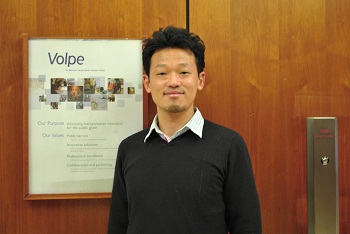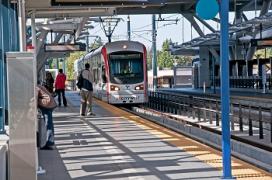Design and Good Sleep: A Researcher’s Focus on Rail Safety
Passengers expect their train operators to be well trained and adhere to posted timetables. They also want their train operators to be well-rested, because the best operator is one who is alert.
 Yoshikata Tanabe, a visiting researcher from Yokohama on a one-year term at Volpe, knows firsthand that a railroader’s schedule may vary daily and that natural disasters and other emergencies can be particularly stressful, making sleep hard to come by.
Yoshikata Tanabe, a visiting researcher from Yokohama on a one-year term at Volpe, knows firsthand that a railroader’s schedule may vary daily and that natural disasters and other emergencies can be particularly stressful, making sleep hard to come by.
Tanabe is supervisor of the Shinkansen—or high speed rail—Crew Depot for the Central Japan Railway Company (JRC). He has worked at all levels of the company, from dispatcher to planner to operator, and he personally understands the fatigue levels that come with different railroad jobs. That’s why he promotes conscientious sleep management to help railroaders stay clear-minded during regular train operations and emergencies.
Tanabe came to Volpe to tap into its expertise on railroader fatigue risk management, including resources such as the Railroaders’ Guide to Healthy Sleep, and study research that can change the sleep culture in Japan, where many think it is best to sleep in spurts of no more than four hours, Tanabe said. At JRC, Tanabe uses employee data to analyze self-reported fatigue levels, but the system is imperfect.
Railroaders at JRC enter their waking and working hours into a fatigue management system. The technology is useful but flawed because it relies on self-reported data, and it can be difficult for a worker to accurately characterize his or her fatigue level. Tanabe has learned about two software tools since arriving at Volpe in July that may help: one lets supervisors access fatigue information to evaluate whether worker fatigue levels are acceptable and the other lets workers track an array of social patterns in their personal and professional lives.
But no fatigue management system is perfect. The best way to promote good sleep is to make railroaders aware of their fatigue, Tanabe said.
While reducing railroader fatigue is primarily about improving safety, well-rested operators also ensure that train networks run smoothly and punctually. At JRC, the Shinkansen must arrive within 15 seconds of schedule, and conductors need to concentrate during an entire run to stay on time. A well-designed station is at the nexus of punctuality and safety, and station design is the other key piece of Tanabe’s research at Volpe.
“It is important to use the concept of human-centric design, not only for our workers but also for our customers,” Tanabe said.
Train station users can be classified broadly as customers and employees, including station staff and train crews. Employees might find a particular location convenient for an office, but passenger flow might dictate that the space be used for ticketing. Design directly impacts punctuality, safety, and the corporation’s bottom line. A good layout that is not bound to old designs and that considers new technologies helps passengers get to trains on time and increases the number of railway users.
A good layout should also consider culture. In Japan, customers want signage everywhere, Tanabe said. On Boston’s MBTA subways, Tanabe has noticed a relative dearth of signs. One design is not better than another—rather, designs should revolve around what customers want, Tanabe said. Tailoring user-friendly designs to specific cultures is important to Tanabe because high-speed rail technology used by JRC may be rolled out in the U.S., and the company would need to know how to fit their knowledge to American expectations.
User-friendly stations and alert train crews make for passengers who are happy and safe—and happy and safe passengers are Tanabe’s primary motivation at Volpe.

